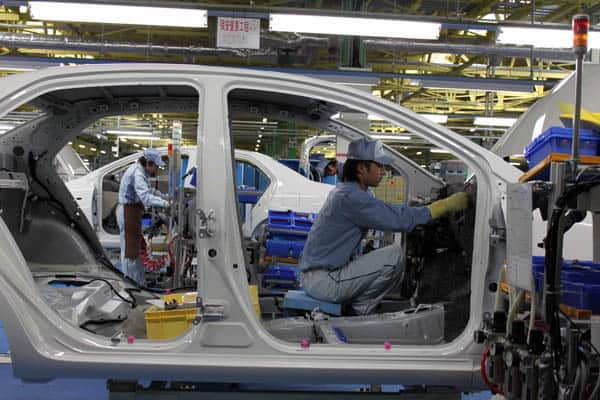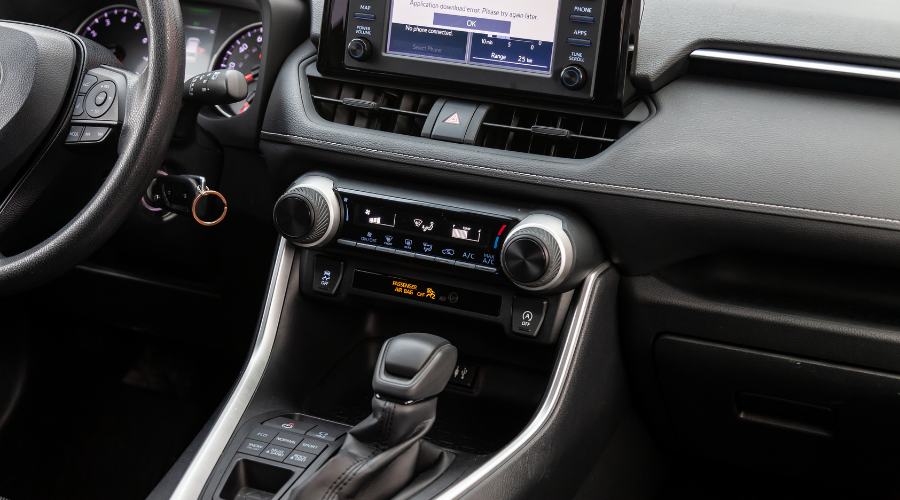Where is the Toyota RAV4 Made? A Global Manufacturing Tour
“Where is the RAV4 made?” – a question that has intrigued car enthusiasts and potential buyers alike. The Toyota RAV4 has blossomed into a vehicle of dependability and adaptability, capturing the hearts of drivers across the globe as a beloved SUV choice. So I looked into the question, where is the RAV4 manufactured or made?
The Toyota RAV4 (including the RAV4 Hybrid) is manufactured or built in Ontario, Canada, and in Georgetown Kentucky, United States. Additionally, the RAV4 Prime and other various trims and packages are produced in two locations in Japan.
Toyota RAV4s are manufactured in four locations around the world including the following plants, organized by country and city:
- Japan
- Tahara, Aichi Prefecture – Tahara Plant
- Miyagi Prefecture – Toyota Motor East Japan
- Canada
- Woodstock, Ontario – Toyota Motor Manufacturing Canada (TMMC)
- United States
- Georgetown, Kentucky – Toyota Motor Manufacturing Kentucky (TMMK)
Each facility plays a crucial role in producing a diverse range of RAV4 models that cater to various regional preferences and requirements.
(Source – Toyota’s global manufacturing network)
Is the RAV4 Hybrid worth it? See a complete guide to determine if the RAV4 Hybrid is worth it for you.
How Can I Tell Where My RAV4 Was Made?
Unraveling the mystery of your Toyota RAV4’s birthplace is a breeze – simply peek at the vehicle identification number (VIN) sticker nestled on the driver’s door. At the base of the sticker, you’ll find the words “Made in the USA,” “Made in Japan,” or “Made in Canada.”
But wait, there’s more! Another subtle clue lies within the VIN itself. Observe the very first character – should it be a “1,” you’ve got yourself an American-made gem. If a “J” graces the initial spot, your RAV4 hails from the Land of the Rising Sun (Japan).
Why is the Toyota RAV4 so popular? See 9 reasons why it is the most popular SUV in America.
How Do I Know if My RAV4 Was Built in Japan?
You can tell if your RAV4 was built in Japan if the vehicle identification number (VIN) starts with a “J,”. Additionally, you can check for it to say “Made in Japan” at the bottom of the sticker on the trim of the driver’s door.
The Honda CR-V and Toyota RAV4 are the top competitors in the compact SUV market but which is better? See which is more reliable, the Honda CR-V or Toyota RAV4.
RAV4 Manufacturing Locations
The birthplaces of the RAV4 are scattered across the globe, showcasing Toyota’s commitment to a diverse and far-reaching manufacturing strategy. Let’s embark on a journey to uncover the specific facilities that create this beloved SUV.
Japan
The Land of the Rising Sun is home to two essential RAV4 production plants.
Tahara Plant – Nestled in the picturesque Aichi Prefecture, the Tahara Plant is a key player in Toyota’s manufacturing endeavors. Here, the RAV4 is meticulously assembled with precision and care.
Toyota Motor East Japan – Located in the lush Miyagi Prefecture, this plant contributes significantly to RAV4 production, ensuring a steady supply of SUVs to eager buyers worldwide.

Canada
Oh, Canada! The Great White North boasts its very own RAV4 manufacturing facility.
Toyota Motor Manufacturing Canada (TMMC) – Situated in the charming city of Woodstock, Ontario, the TMMC diligently produces RAV4s tailored to the North American market.
United States
In the land of stars and stripes, the RAV4 finds yet another home.
Toyota Motor Manufacturing Kentucky (TMMK) – The bustling town of Georgetown, Kentucky, hosts this vital production plant. Here, American-made RAV4s roll off the assembly line, ready for adventure.
With these manufacturing locations spread across different continents, the RAV4 truly embodies a global phenomenon, captivating drivers and car enthusiasts alike.
Is the RAV4 a good car? See this in-depth review on whether or not the RAV4 is an all-around good car.
Differences in RAV4 Models by Region
The RAV4’s global presence necessitates a tailored approach to its various iterations. As we explore the unique characteristics of RAV4 models across regions, we’ll uncover the secret recipe for the SUV’s worldwide success.
North American Models
Catering to the needs and preferences of drivers in the United States and Canada, the North American RAV4 boasts distinct features:
- Engine Options – A robust selection of powertrains, including a 2.5-liter gasoline engine, a hybrid variant, and the powerful RAV4 Prime plug-in hybrid.
- Technology and Amenities – North American models come equipped with advanced infotainment systems, smartphone integration (Apple CarPlay and Android Auto), and an array of convenience features.
Is the RAV4 Hybrid tax credit eligible? See if the RAV4 Hybrid qualifies for a federal tax credit.
European Models
Designed to appeal to the discerning tastes of European drivers, the RAV4 sports unique attributes in this region:
- Efficient Powertrains – Emphasizing fuel efficiency and eco-friendliness, European RAV4 models predominantly feature hybrid and plug-in hybrid options.
- Compact Dimensions – With slightly smaller dimensions, the European RAV4 is better suited to navigate the narrow streets and tight parking spaces found in many European cities.
Asian Models
In its homeland and neighboring countries, the RAV4 caters to the distinct preferences of Asian drivers:
- Localized Features – Certain Asian markets, such as China, may offer unique features or trim levels tailored to local tastes and requirements.
- Affordability and Efficiency – Focused on providing value and economy, the Asian RAV4 models often prioritize fuel-efficient powertrains and budget-friendly configurations.
Through these regional variations, the RAV4 demonstrates its versatility and adaptability, endearing itself to a diverse array of drivers around the globe.
Toyota’s Manufacturing Philosophy
Understanding the origins of the RAV4 requires delving into the heart of Toyota’s manufacturing principles. The company’s approach to production has shaped not only the RAV4 but the entire automotive industry.
Want to know how much cargo space the RAV4 has? See a detailed breakdown of the RAV4 cargo space and dimensions with photos.
The Toyota Production System (TPS)
At the core of Toyota’s manufacturing philosophy lies the TPS, a revolutionary approach to production that has become the gold standard in the industry:
- Continuous Improvement – Known as “Kaizen” in Japanese, the pursuit of continuous improvement drives Toyota to refine and optimize its processes constantly.
- Respect for People – Toyota places great importance on nurturing a culture of mutual respect, collaboration, and personal growth among its employees.
- Elimination of Waste – The TPS aims to minimize waste and inefficiencies, focusing on value-added activities in the production process.
Just-in-time Production and Lean Manufacturing
Toyota’s innovative manufacturing techniques have become synonymous with efficiency and quality:
- Just-in-time (JIT) – This approach ensures that parts and materials arrive at the assembly line precisely when needed, reducing inventory costs and improving productivity.
- Lean Manufacturing – By streamlining processes and eliminating waste, Toyota has created a lean and agile production system that is both cost-effective and environmentally friendly.
Toyota has not only elevated the RAV4’s production standards but also transformed the way vehicles are made around the world.
Brief History of the RAV4
Let’s take a stroll down memory lane and explore the origins and evolution of the RAV4.
What is the size of the RAV4 gas tank? See RAV4 gas tank size in all RAV4 models and years.
Origins and First Generation
The RAV4’s story began in 1994 when Toyota set out to create a new breed of vehicle.
Concept and Design – Blending the best of both worlds, the RAV4 combined the off-road capabilities of a traditional SUV with the comfort and maneuverability of a compact car. The result was a compact crossover SUV that would reshape the automotive landscape.
1994 Debut – The first-generation RAV4 made its grand entrance in 1994, enchanting drivers with its unique charm and innovative design.
Evolution of the RAV4 Over Time
As the years went by, the RAV4 evolved with the times, adapting to new trends and technologies while maintaining its core identity:
- Second Generation (2000-2005) – The RAV4 grew in size and sophistication, introducing a smoother ride, enhanced safety features, and improved performance.
- Third Generation (2005-2012) – This era saw the RAV4 gain a more aggressive stance, with bolder design elements and increased power under the hood.
- Fourth Generation (2012-2018) – Embracing a sleek and modern aesthetic, the RAV4 became even more refined and fuel-efficient, appealing to a wider audience.
- Fifth Generation (2019-Present) – The latest RAV4 iteration incorporates cutting-edge technology and bold styling, with the introduction of hybrid and plug-in hybrid (RAV4 Prime) options for eco-conscious drivers.
Through its various transformations, the RAV4 has solidified its position as a beloved and reliable SUV, winning over the hearts of drivers worldwide.
What exterior colors does the RAV4 come in? See a breakdown of all the 2023 RAV4 colors and which trim offers which color.
Frequently Asked Questions
Indeed! RAV4s proudly roll off the assembly line at the Toyota Motor Manufacturing Kentucky (TMMK) plant in Georgetown, Kentucky, showcasing American craftsmanship and ingenuity.
Absolutely! The Toyota Motor Manufacturing Canada (TMMC) facility in Woodstock, Ontario, is dedicated to producing RAV4s tailored to the North American market.
Japanese-built RAV4s emerge from two key production sites: the Tahara Plant in Aichi Prefecture and Toyota Motor East Japan in Miyagi Prefecture. These facilities contribute significantly to the global supply of RAV4 models.
While sharing core characteristics, RAV4 models from different regions can feature unique specifications, such as engine options, trim levels, and localized features. These distinctions cater to the preferences and requirements of drivers in various markets, ensuring that the RAV4 remains a versatile and adaptable choice worldwide.







